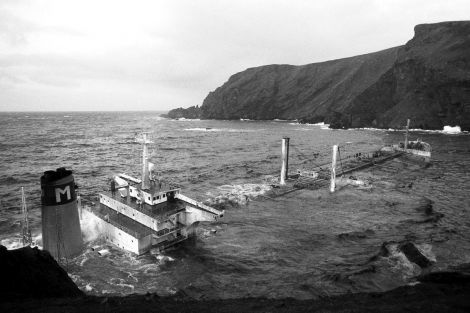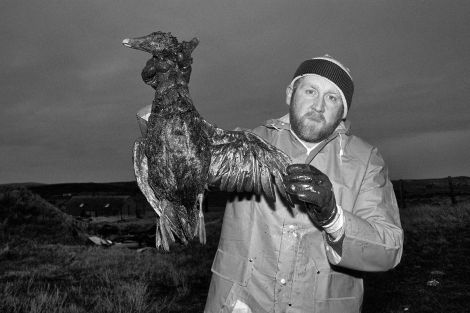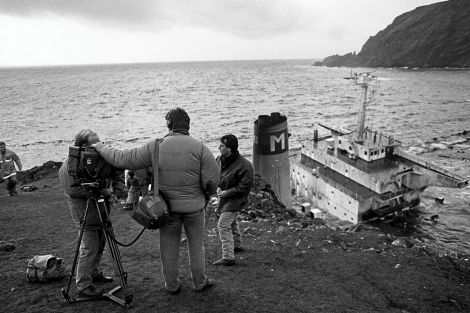Features / Braer – 20 years on…could it happen again?
WHEN the Liberian registered tanker Braer ran aground at Garths Ness in the morning of 5 January 1993 spilling her entire cargo of 84,500 tonnes of crude oil and almost 2,000 tonnes of bunker fuel, a nightmare Shetlanders had long dreaded began to unfold.
Shetland was very lucky and escaped relatively unharmed.
The community had prepared itself for an oil disaster ever since the arrival of the oil industry on these shores, but in this case was helped by violent storms breaking up the light Gullfaks oil.
Twenty years on, the disaster is slowly fading from the public mind.
To mark the anniversary, Shetland News has spoken to four local people who played a key role in the dramatic days following the oil spill about their involvement and the lessons learned.
Coastguard winchman Friedie Manson played a crucial role in getting the 34 crewmen off the stricken vessel and later the same morning returned to the drifting vessel in a last attempt to get a tow line attached.
“There were two parts to this. Initially we were tasked at around 5.40am to go to the Braer to take off non-essential crew because it looked like she was drifting towards Sumburgh Head. It was still dark, very windy and a heavy sea with a swell of up to 16 metres, and a vessel with no power.
“We took off ten and then went back to Sumburgh, while Rescue 167 from Lossiemouth took off the rest of the crew because at that time it was thought the Braer might drift on to the rocks sooner.
“But then the tide took over from the wind as she came into the Roost and she started drifting westwards, which was an unbelievable sight. She cleared Sumburgh Head and then she cleared Scatness, and we were all hoping she would clear Fitful Head as well.
Become a member of Shetland News
“When the tug Star Sirius arrived on scene it was decided to put a party back on board to receive a tow line from the tug. When we arrived back the wind had pushed the Braer out of the tide race and nearer into Quendale Bay, so four of us, Jim Dickson (the deputy head at the council’s marine operations department), myself, the chief engineer and one of the crew were winched back onboard.
“The first rocket line they fired missed the vessel completely; the wind just took it and blew it away, so they fired another rocket line. That one was fired straight over the bridge and got tangled up in the lifeboat.
“I got myself to the port side, climbed over and got into the lifeboat to get hold of the line and got it back to the stern, which wasn’t an easy task, because there were no rails on that side.
“We started pulling the tow line and we possibly got half of it, but we had to give up because the swell was pulling it from us. By that time we were getting pretty close to the rocks anyhow, and the Star Sirius said it was too close for her to come in any further. Shortly afterwards we grounded on the rocks at Garths Ness.
“There was this horrible crunching sound, and the next wave that came in lifted the whole tanker up and set it on to the rocks. I must admit I was fairly frightened at that point. Shortly after that Oscar Charlie winched us clear of the vessel.”
The Braer grounded at 11.15am. By this time hundreds of islanders had been watching in horror as the vessel drifted past Sumburgh Head and Scatness at the mercy of the tide, waves and a force 10 southerly wind.
One of them was ornithologist Martin Heubeck who helped co-ordinate the wildlife response made up of around 150 volunteers collecting around 2,000 casualties from beaches and coastlines. He was alerted to the impending disaster at 5am.
“I had a quick shower and then went up to Sumburgh Head to see what was happening. It was one of these events that, if you were on the scene, you had to see happening.
“I drove over to Quendale Farm and was walking over the hill towards her and all of a sudden the smell of oil was overpowering, that must have been just seconds after the impact.
“Initially no one knew what this Gullfaks crude was going to do. At first light on the morning of the sixth of January I was down on Quendale beach realising that something was very odd, because the sea was just the colour of milky tea and the beach was, essentially, clean.
“This oil/water emulsion was washing up the sand and was washing back again. So it wasn’t that we were up to our ankles in thick oil; of course this emulsifying effect continued with the storms. Instead of what might have been anticipated as six months of field work, after three weeks we stood the beach teams down.
“If the Braer had been carrying a different kind of oil, say the sort of oil the Sea Empress in Pembrokeshire had been carrying (February 1996), and if it had been April or May and not the middle of winter, we would have had a very different scenario.
“I don’t think anybody who was closely involved in the few weeks after the Braer grounded will ever forget it. Certainly it was a very traumatic experience for a lot of people.
“In some ways I am glad I saw it, I am glad I learned from the experience. We took some of that experience down to Galicia in 2002 when the Prestige sunk off the Spanish coast. We helped them to establish a more effective wildlife response in terms of dealing with the dead birds and the scientific recording and processing of that.”
One man who did not see the Braer go aground because he was already busy filing news copy to the national press was local journalist, now councillor, Jonathan Wills.
He became closely involved with the story, wrote a book with co-author Karen Warner (Innocent Passage, Mainstream Publishing, 1993), and revealed “What REALLY happened on the Braer?” in an article published in the Sunday Herald and the Shetland Post, in 2001.
“I didn’t see the Braer the first day. I was up in my office all day, making phone calls and filing copy. It just went mad – everybody was thinking Exxon Valdez. (the Alaskan oil spill of March 1989)
“There was a period of a couple of hours, when the crew was desperate to get back on board the vessel, but the police held them back. Eventually some of them got back on, but it was too late and at 11.15 she went aground. I thought the whole place was going to be obliterated.
“One of the things the council did very well was to set up an emergency centre at Sumburgh airport straight away, where the press could get information. The place was swamped with journalists and as the local stringer I made quite a lot of money the first days.
“But I had a problem. Because I was local and I have lived here since the age of 15, I was quite involved in Shetland and I was committed to it. It was hard to remain detached and dispassionate, very hard indeed.
“We got hold of a radio transcript of the radio traffic between the coastguard helicopter, the ship and the coastguards, and from that it was very clear that there was a lot of confusion on board the ship.
“But it was only seven years later that I found a carrier bag lying on one of the seats on my boat. In the bag were the complete papers of the enquiries into the Braer, including, in Norwegian, the transcript from the oil terminal’s log.
“When I got the logs translated and double-checked, it turned out that what was broken on the Braer was the main steam-pipe, and not the coldwater feed pipe into the boiler as we were told.
“The ship should never have been allowed to leave Norway. But she sailed into a gale, and we know the rest.
“I was invited to serve on the marine safety sub-committee. It took us eight years of hard arguing until we got a rescue tug for Shetland, which is now, of course, under threat again.
“We started a campaign to get radar cover for Shetland’s coastline which still doesn’t exist, but what we did get was the Automatic Identification System (AIS), which all tankers now have. That was a major step forward, not just for Shetland, but everywhere.
“I learned a lot about tankers and how they work. I became, if possible, more cynical about the oil industry and the oil shipping industry, and in some ways I became more hopeful because it was possible for a group of concerned citizens acting together to make improvements.
“We did that, and I think Shetland is now a safer place after the Braer, and so are many other places.”
As Shetland Islands Council’s director of marine operations and deputy chief executive Capt George Sutherland, now retired, led the response for the local authority.
As the council’s representative on national and international bodies concerned with safety at sea, he also became closely involved in the aftermath of the Braer.
Having detailed inside knowledge of how government and big business work, Sutherland’s verdict is a more depressing one. Asked directly if Shetland was better prepared for an oil spill 20 years on, his response was an emphatic ‘No’.
“How did the Braer change me? All that it did was to put a little bit more iron in my soul, I suppose, adding to my resolve to pursue the preventative route which was the watchword for operations at Sullom Voe and around Shetland for a lot of years.
“It ensured that I spent the next few years heavily engaged with decision makers in Europe and central government with the view of trying to make sure that as far as we were able to we had the best prevention measures in place to help cope with an accident if and when it happens again.
“It means that I have very strong views today about what needs to be in place and what should be in place and, perhaps, what isn’t in place as it should be after 20 years, because corporate memory disappears as people retire, and public consciousness diminishes when 20 years have elapsed since the last major accident.
“And, of course, it is very difficult for a new generation to devote attention to something that might never happen but indeed happened 20 years ago.
“The sea never changes; it can destroy as we have seen these last few weeks. People don’t change; people make mistakes. These mistakes are usually made at a boardroom level. They create very often the circumstances that make accidents more likely.
“I have said it many times: this country and perhaps most of the developed world suffers from what is widely described as ‘sea-blindness’.
“There is no interest ashore at what happens at sea, and for that reason we see the coastguard being leaned upon and being rationalised as they say today: we see the government taking the view that emergency towing vessels are too expensive to deploy in the UK (that is not the view taken by other European governments who watch in amazement, I think, at what is being done in the UK).
“Also Shetland Islands Council is under severe financial pressure and much of the strength and depth that existed at Sullom Voe 20 years ago has now gone. I wish I was more confident that the council of today had the same focus on matters of this kind as they did 20 years ago.”
Shetland News would like to thank all four contributors for their time speaking to us and local photographer Malcolm Younger for giving permission to publish some of his photos taken 20 years ago.
What are your memories and thoughts of the Braer? If you would like to share them with us and our readers please e-mail us at views@shetnews.co.uk
Become a member of Shetland News
Shetland News is asking its many readers to consider paying for membership to get additional features and services: -
- Remove non-local ads;
- Bookmark posts to read later;
- Exclusive curated weekly newsletter;
- Hide membership messages;
- Comments open for discussion.
If you appreciate what we do and feel strongly about impartial local journalism, then please become a member of Shetland News by either making a single payment, or setting up a monthly, quarterly or yearly subscription.



































































